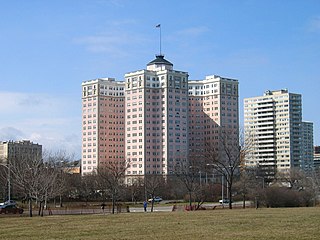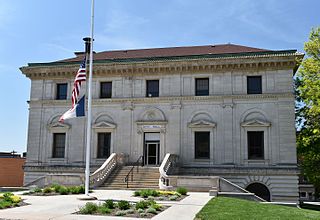
The Bryn Mawr Historic District is on the lakefront of the Edgewater neighborhood of far-north Chicago, Illinois. It extends along Bryn Mawr Avenue between Broadway Avenue and Sheridan Road. Its most prominent features are the Belle Shore Apartment Hotel, Bryn Mawr Apartment Hotel, Edgewater Beach Apartments, Edgewater Presbyterian Church, Manor House, and the northernmost area of Lincoln Park.

The College Hill Town Hall is a historic village hall in the city of Cincinnati, Ohio, United States. Built as village offices for College Hill when it was a separate community, the building was designed by a master architect, and it has been named a historic site.

The Richard H. Mitchell House is a historic residence in Cincinnati, Ohio, United States. Built of stone throughout, this large house was designed by prominent Cincinnati architect Samuel Hannaford. Converted into a school, the house has been named a historic site.

The East Dubuque School, also known as the Bell Tower Retirement Community, is a historic Romanesque Revival school building in the Mississippi River city of East Dubuque, Illinois, United States. It was constructed in two sections, one in 1893, the other in 1914 and designed by local architect Thomas Carkeek. The building was listed on the U.S. National Register of Historic Places in 1982.

The Roosevelt Building is a high-rise residential building located along 7th Street in Downtown Los Angeles. It was completed in 1926 and was designed by Claude Beelman and Alexander Curlett in an Italian Renaissance Revival style. It was later converted to lofts.

The Grand Riviera Theater was a movie palace theater located at 9222 Grand River Avenue in western Detroit, Michigan. It took its name from Grand River Avenue. It was designated a Michigan State Historic Site in 1980, and listed on the National Register of Historic Places in 1982, but was subsequently demolished in June, 1996. The building was removed from the National Register in 2020.

Leland Castle is a building in New Rochelle, New York. It was constructed during the years in 1855 - 1859 in the Gothic Revival style, and was the country residence of Simeon Leland, a wealthy New York City hotel proprietor. Leland began to assemble an estate as early as 1848, and in 1855, began the erection of this palatial 60-room mansion. The home was designed by New York City architect William Thomas Beers. A north and south wing were added to the castle in 1899 and 1902 respectively.

Tifton Commercial Historic District, in Tifton in Tift County, Georgia, is a historic district that was listed on the National Register of Historic Places (NRHP) in 1986 and expanded in 1994. The original listing was portions of 10 blocks including buildings from the 1890s to the late 1930s, most built of brick.

Cooper Arms Apartments is a registered historic building located on Ocean Boulevard in downtown Long Beach, California. The twelve-story Renaissance Revival apartment tower was built in 1923. It was one of the first structures to be designated a Long Beach Historical Landmark when the city launched its historic preservation program in 1980, and it was added to the National Register of Historic Places in 2000. It is currently operated as condominiums.

The Downtown Athens Historic District is a historic area in the Downtown Athens neighborhood of Athens, Georgia. It was listed on the National Register of Historic Places in 1978. Its boundaries were revised twice, in 1984 and 2006, and additional documentation was filed in 2006.

The Downtown Waterbury Historic District is the core of the city of Waterbury, Connecticut, United States. It is a roughly rectangular area centered on West Main Street and Waterbury Green, the remnant of the original town commons, which has been called "one of the most attractive downtown parks in New England."

The Jastro Building, also known as the Standard Oil Building, is a historic office building in Bakersfield, California. The structure was placed on the National Register of Historic Places (NRHP) on September 22, 1983.

The Superintendent's Residence at the Utah State Hospital is a historic house located at the Utah State Hospital in east Provo, Utah, United States. It was listed on the National Register of Historic Places in 1986.

Ottumwa City Hall is the official seat of government for the city of Ottumwa, Iowa, United States. The building originally served as a post office and federal courthouse. It is part of the Central Park area, which includes: Ottumwa Public Library, Wapello County Courthouse and St. Mary of the Visitation Catholic Church. The building was listed on the National Register of Historic Places in 1976.

The Journal Building is a historic commercial building at 325-331 Water Street in downtown Augusta, Maine. Built in 1899 to a design by Arthur G. Wing, it is a fine local example of commercial Renaissance Revival architecture. It was for main years home to Augusta's leading newspaper, the Kennebec Journal. It was listed on the National Register of Historic Places in 1986. It is now occupied by facilities of the University of Maine at Augusta.

Winterset Courthouse Square Commercial Historic District is a nationally recognized historic district located in Winterset, Iowa, United States. It was listed on the National Register of Historic Places in 2015. At the time of its nomination the district consisted of 82 resources, including 74 contributing buildings, seven noncontributing buildings, and one noncontributing object. The historic district covers most of the city's central business district in the original town plat. Most of the buildings are two-story, brick, commercial buildings. The commercial Italianate style is dominant, with Queen Anne, Romanesque Revival, and Neoclassical styles included. The Madison County Courthouse (1878) is a Renaissance Revival structure designed by Alfred H. Piquenard. Most of the buildings are brick construction, but four were constructed using locally quarried limestone. The stone buildings include the courthouse, the White, Munger and Company Store (1861), and the Sprague, Brown, and Knowlton Store (1866), all of which are individually listed on the National Register.

Fire Station No. 2, also known as El Mecca Shrine Club, is a historic building located in Waterloo, Iowa, United States. The city's paid fire department dates from 1904. Prior to that Waterloo was served by private fire companies. Built in 1907, this is the only early fire station left in the city. This building is an eclectic combination of the Renaissance Revival and the Romanesque Revival styles. It was designed by the prominent Waterloo architect John G. Ralston. The decorative elements on the main floor are found in the columns with foliated capitals that support a broad entablature. The second story is primarily brick with lighter stone accents for a polychromatic effect. The building was used as a fire station until 1969 when the city built five new stations. Black Hawk County used the building as an office to issue food stamps. El Mecca Shrine acquired the building in 1976 and converted it into a restaurant and club. It was listed on the National Register of Historic Places in 1988.

Emerson School is a historic building located in Waterloo, Iowa, United States. It is oldest extant school campus on the city's west side. Emerson was established in 1893 when its first building was constructed on this property. It was the third school in West Waterloo. The original building was replaced when the present main building was completed in 1906. The annex was built ten years later to accommodate the school's increased enrollment. They are connected by a hyphen. The complex was designed by Waterloo architect John G. Ralston. The original building is a two-story brick structure on a raised limestone basement designed in the Neoclassical style. It features broken pediment gable ends, stylized pilasters on the gable ends of the upper level, Palladian dormers, and corner pilaster capitals. The annex was designed in the Second Renaissance Revival style. It is also a two-story brick structure. Typical of this style the annex features distinct horizontal divisions separated by belt and stringcourses. There is also a parapet frieze across the top. In 1973 the building became Expo Alternative High School. The building was closed in 1981, and it was later sold. It was listed on the National Register of Historic Places in 2004.

Mount Pleasant City Hall is the official seat of government of the city of Mount Pleasant, Iowa, United States. This 1½-story stone structure was designed by Burlington, Iowa architect William Weibley, and constructed by local builder K.A. Bergdahl. It is an eclectic combination of Colonial Revival styles. For the most part it reflects Georgian Revival aesthetics with its symmetrical facade and the pilasters that flank the main entrance. The stepped ends of the gable roof and the projecting gable above the main entrance reflect the Dutch Revival influence. The random ashlar stone used in its construction was salvaged from the Seeley Memorial YMCA-high school that was destroyed in a 1932 fire. The city hall's construction in 1936 was a Works Progress Administration project. The east wing, which has been altered from its original appearance, originally housed the city's police and fire departments before they moved to their own buildings. City hall was listed on the National Register of Historic Places in 1991.




















